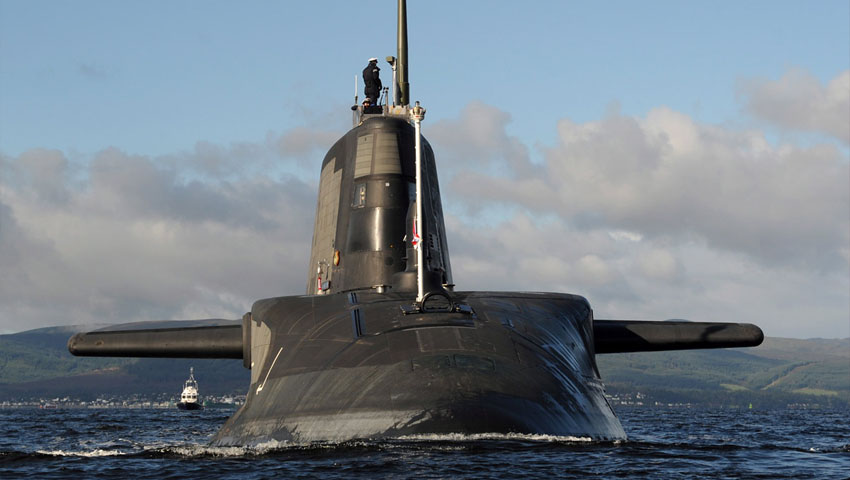Following a week of continued tensions culminating in the Iranian seizure of British flagged tankers, the Royal Navy has steadily begun bulking up its presence in the Persian Gulf – this time deploying an Astute Class nuclear-powered attack submarine to serve as a tactical and strategic force multiplier.
To continue reading the rest of this article, please log in.
Create free account to get unlimited news articles and more!
The war of words between a seemingly recalcitrant Iranian leadership and US and UK-led alliance has escalated with the seizure of British-flagged tankers by special operations forces from Islamic Revolutionary Guard Corps (IRGC), prompting renewed responses from both sides as once again the world waits with baited breath.
The US presidential election of Donald Trump in 2016 and the appointment of hawkish National Security Adviser John Bolton signalled an end to the seemingly more conciliatory relationship between the two adversaries – marking a return to the more confrontational style of the preceding Reagan and Bush administrations and a significant rise in the tensions.
In recent months, the tensions between Iran and the West more broadly have begun to bubble over – particularly following a series of attacks on oil and natural gas tankers in the Persian Gulf and the Gulf of Oman, threatening the global supply of liquid fuel and thus the global economy. This has prompted a resurgence of US military presence in the region, including:
- The USS Abraham Lincoln carrier strike group;
- Four B-52H Stratofortress strategic bombers;
- Patriot Missile batteries;
- An additional 5-10,000 US troops in support of the existing 60-80,000 US troops as part of US Central Command (USCENTCOM); and
- The recent deployment of the USS Boxer Expeditionary Strike Group and the Royal Navy's HMS Duncan, a Type 45 Class guided missile destroyer, and HMS Montrose, a Type 23 guided missile frigate.
Building on this following renewed sabre rattling and provocations on both sides has culminated in the IRGC capture of the British-flagged oil tanker Stena Impero while passing through the narrow, strategic waterway of the Strait of Hormuz, following similar operations conducted by Royal Marine Commandos descending on Grace 1, an Iranian oil tanker suspected of carrying oil to Syria in blatant disregard for international sanctions against the Syrian regime.
As the confrontation continues to spiral beyond a war of words, with military forces currently being deployed to counter one another's moves, the UK has stepped up its presence in the region with the Royal Navy reportedly deploying an Astute Class nuclear attack submarine to reinforce Her Majesty's Ships Duncan and Montrose and the Royal Fleet Auxiliary replenishment vessel Wave Ruler.
This renewed and expanded UK presence comes as Foreign Secretary Jeremy Hunt told his Iranian counterpart, Mohammad Javad Zarif, "[UK vessels] must and will be protected", reaffirming the UK's commitment to directly challenge renewed aggression in the region. Furthermore, The Sun has reported that the Royal Navy will forward deploy M Company of the Royal Marines 42 Commando.
However, the most potent tactical and strategic force multiplier is the deployment of the 7,400 ton Astute Class nuclear attack submarine, which will be providing advanced intelligence, surveillance and reconnaissance roles, with a secondary focus on tactical and strategic deterrence, according to senior Royal Navy sources as reported in The Sun.
Reinforcing this, the senior sources state that the submarine will focus its attention on the Iranian port of Bandar Abbas and the IRGC and Iranian Navy's fleet of midget submarines and small, fast attack boats, which pose an asymmetric threat to international shipping traversing the Strait of Hormuz.
The Royal Navy's deployment of a submarine highlights the tactical and strategic deterrence capabilities such platforms posses and the force multiplying capacity submarines fill in contemporary force structures when deployed either independently or to operate as part of a larger naval task group providing important tactical and strategic operating concepts for Australia.
Questions remain for Australia
Despite Australia’s enduring commitment to the Australia-US alliance, serious questions remain for Australia in the new world order of President Trump’s America, as a number of allies have been targeted by the maverick President for relying on the US for their security against larger state-based actors, which has seen the President actively pressuring key allies, particularly NATO allies, to renegotiate the deals.
For Australia, a nation defined by its relationship with traditionally larger, yet economically weaker, regional neighbours, the growing economic prosperity of the region and corresponding arms build-up, combined with ancient and more recent enmities, competing geo-political, economic and strategic interests, places the nation at the centre of the 21st century’s "great game".
Get involved with the discussion and let us know your thoughts on Australia's future role and position in the broader US alliance structure and the Indo-Pacific more broadly in the comments section below, or get in touch with

 Login
Login







